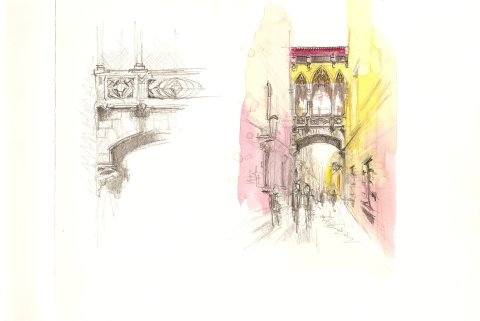St Eulalia Cathedral, Barcelona
November 29, 2012
graphite pencil 8B
Another daily drawing from photographs in the “virtual” Barcelona series. Even at one District a week, this series will go for ten weeks. I can’t imagine going to Barcelona in person without beforehand doing the necessary ‘observational’ research inherent in sketching.
Not sure yet exactly what the particular characteristics of Catalan Gothic architectural style are, but the principal Christian church in the Barrio Gotico, the oldest District 1 of Barcelona, is the medieval Cathedral, supplanting an earlier Romanesque building. It has a large cloister attached which has the air of a tropical rainforest and in which live 13 famed geese, symbolic of the saint who died aged 13. The interior of the church is extraordinarily ornate, but I thinks lacks the standard transept.
I’m not aware of the words for “church” or “cathedral” in Judeo-Spanish/Ladino or Medieval Spanish, but (further to yesterday’s sketch), the Ladino word for “synagogue” is certainly kal.
Virtual Barcelona – District 1, El Call
November 28, 2012
El Call rhymes with “sky” and is both the name of a street as well as being the general name for the Jewish Juderia or ghetto (the latter being an Italian word from the Jewish quarter of Venice). Jews of Barcelona contributed to law and the arts and while free during the day were routinely locked up at night. Immediately to the south of the Placa de St Jaime, St Eulalia Cathedral and the Medieval (and contemporary) secular seats of power were two tiny areas of tall buildings and dark, narrow lanes, one called the Big Jewish Quarter and another called the Small. Convivencia or happily living together with Moslems and Christians was okay for a long time but Jews suffered increasing restrictions on their power, human rights and their physical movements from the 12th century onwards. Of course, all Jews were eventually expelled from Spain in 1492. Today, Barcelona’s Jews live elsewhere in the main, with synagogues elsewhere, but the historic Jewish presence in the Barrio Gotico has been under scrutiny lately and one can now visit an underground former Synagogue. A prominent Jewish centre was the town of Girona, some 15kms outside Barcelona.
In terms of urban sketching, El Call proffers opportunities for stark tonal work. The scan hasn’t picked up any of the subtlety of colour from pastel pencils over Pilot Varsity (purple ink) over watercolour wash. I’ll include more realistic tonal thumbnails on the page opposite: all these sketches are done on the right-hand page, with the left-hand page free for maps, information, thumbnails and other contextual material.
Virtual Barcelona – District 1, El Carrer del Bisbe
November 27, 2012
A4 landscape format, 150gm Daler-Rowney sketchbook. Quinacridone Gold and Permanent Magenta, Winsor & Newton watercolours.
Pont neogotic entre el Palau de la Generalitat i la Casa dels Canonges.
This is a new series devoted to Barcelona, Spain – a form of “armchair” urban sketching since the sketching will be drawn from photographs. With 120 pages in the sketchbook, I want to cover not just the many UNESCO heritage buildings or the many radical buildings of architect Gaudi and other moderns from early last century, but touching as well on everyday life in this very vibrant city. I want to work through the city’s ten districts at the rate of several double-page spreads per district and today start with District 1, the Barrio Gotico, the city’s oldest and quite close to the harbour area.
The view is the Carrer del Bisbe or “Bishop’s Street”, a narrow street dividing the Canon’s Residence (Barcelona’s cathedral is next door) and the Provincial Council building, the Diputacion. It is apparently one of the original Roman streets, given that the Roman walled city sat diamond-shaped with gates at each point of the compass (the Western gate at Placa Nueva and the eastern gate at Placa del Berenguer el Grande). This quarter is now closed to vehicular traffic, like most historic city centres in Spain and Italy. Gothic buildings were installed in the 13-15th centuries on a 4th century basilica and a palace of Christian Visigoths, themselves built on traces of the original Roman settlement after foundation of a port called Barca by the Phoenicians. I’m unsure about the relationship between Carrer del Bisbe and Carrer Obispo Inurita, but street musicians enliven these narrow alleys, especially in the late afternoon.
A neogothic (1883-1895) , covered gallery, over a star-vaulted arch, spans Bishop’s Street (also called Caller Obispo Inurita in some sources) to link the Diputacion (Palau de la Generalitat, the seat of Catalan Government) building with the canon’s residence, the Casa dels Canonges. Reflecting the rather confused identity of this area, this bridge was built in 1928 bridge by Joan Rubio, student of Gaudi and is a more elaborate version of a very similar one in the Jewish quarter in Toledo. Literally around the next corner at El Call is the old Jewish quarter of Barcelona, the subject of my next sketch.
References
http://www.google.com – The vehicular camera taking Google Maps street view can’t go down either this Caller or the other narrow pedestrian-only lanes in the adjacent Jewish quarter. The street view does however provide wonderful visual context by showing the Placa de S. Jaime at the Caller’s eastern end and the road, El Caller Ferran, leading down to the Rambla a few blocks away to the south. You get a real sense of just how “closed up” the Gothic quarter is – narrow streets, dark from the tall stone buildings and almost sun-less.
Spain. Michelin green guide, 1974. I wouldn’t go anywhere overseas without the relevant green Michelin guide!


